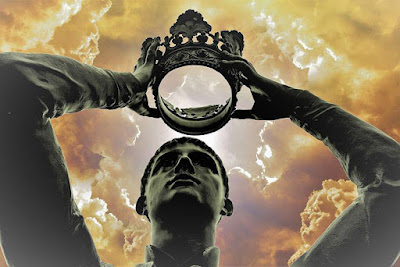The imagery in Macbeth is characterized by subtly, variety and imaginations. A truly poetic taste unlike any other Shakespearean drama or play is given to the characters, ideas, and advances throughout the play thanks to the imagery's richness and constancy. It is used to set the tone of a passage, provide contrast and irony to the scenes.
Theatre performances in the seventeenth century were seen to be public events attended by both the wealthy and the lower classes. In order to engage their senses and arouse their enthusiasm, the audience throughout the Jacobean period focused on the complex and colourful vocabulary. Because there wasn't much in the way of scenery or objects, the sensual language was an essential and inevitable element.
Macbeth maybe described as the depiction of the internal battle between good and evil for possession of man's soul. To make the confrontation between the forces of life , and that of Darkness vivid, Shakespeare employs images abundantly and imaginatively.
The two principle sets are those of Darkness, evil and negation.; life forms, health and regeneration - thus highlighting the contrast and heightening the tension. There exist many other subsidiary images- those of clothes, confusion and moral squalor (squalid)- which further convey the horror of ubiquitous evil, and some, which can weigh the light of life, virtue and benevolence. According to Caroline Spurgeon, compared to other plays or dramas, Macbeth's imagery "appears to me to be more rich and varied, more highly imaginative, and more unapproachable by any other writer."
"Darkness," Andrew Cecil Bradley writes , 'broods over this tragedy". The images of light and darkness are interwoven. From the very first scene, a sombre, fearsome atmosphere sets in through the introduction of the' secret, black and midnight hags.' remarkable that almost all the sea in which remain in ones memory are set in darkness. The presence of the witches is accompanied by upheaval in nature,their odious ominous locution - " fair is foul, and foul is fair, hover through the fog and filthy air". Representatives of the decadence, confusion and desecration to follow at" the set of sun." Edward dowden says that the movement of the whole entire play maybe sommed up encompassed in the words" good things of day begin to drop the drowse."
The Evil being done is so horrible that it would be a damning site to one's eyes, thus the darkness, 'the fog and filthy air' - are necessary. It is Ironic that it is Duncan who first start the idea of stars as being a symbol of nobleness when he confers an hour on his son -" signs of nobleness, like stars, shell Shine on all deservers." Macbeth immediately realises that Malcolm is an added obstacle in his path. His m murderous impulses are awakend as he cries - " stars, hide your fires. Let not light see my black - deep desires." the idea that only darkness can hide such Evil deeds is ever present from this point on. Lady Macbeth's invocation of Darkness strictly similar to her husband- come, thick banquo being instinctively aware of the tension and unnatural situation, remarking-" there's husbandry in heaven. Their the following day" darkness does the face of the earth entomb when leaving light should kiss it". The sight to gruesome that macduff cries- approach the chamber and destroy your site within you gorgon.
The colour of blood, second in importance only to darkness appears like a Wagnerian leitmotif. Leading captain is the initiator of this series of images. Blood, both real and imaginary continually haunts Macbeth and his wife. Macbeth blood stained hands are reminder of his crime. His hands making the green one red is a stirring image. Even more awe inspiring is the image of him wading through a river of blood - " I am in blood stepped so far" that returning would be Tedious as moving forward. Blood is seen or rather not seen, in the iconic sleepwalking scene " out, damned spot! Out, I say" Images of blood have been repeatedly employed in Macbeth to create an atmosphere of horror. Images of order and health are presented with a scene of Royal order when King Duncan is seen distributing justice and rewards. The supper at Macbeth's castle leaves Duncan in "unusual pleasure" and "measureless content" because it is associated with order.
Confusion and diseases are the other images present. Macbeth act is it seen against the natural order and this is emphasized by the imagery. Natures protestation against this Breech is seen in the acts of an owl killing a falcon, horses devouring each other , an earthquake.
A simple yet effective image use by Shakespeare is that of clothes. The new honours showered on him constantly gives Macbeth the feeling of having to put on loose and badly ill fitting garments, belonging to someone else.
There is also a certain violence in the imagery. Images of the babe torn smiling from the breast and being dashed to death, pouring the sweet milk of Concord into hell, of sorrows striking heaven on the face, of the mind on a rack, of the mind being full of Scorpions- the imagination moving on a "wild and violent sea."
Till before the murder of Duncan, the clothing imagery is used to refer to respectable abstractions- duncans clothes being compared to honour , love and trust. After his death, there is a radical change in its symbolism, the imagery being used to create a curiously humiliating degrading effect. Caithness sees him as a man vainly trying to fasten a large garment on, with two small belt-" he cannot buckle his distempered within the belt of rule." Angus provides us with the almost comical image a short ignobel man trying to fit into a coat which is far too big, thus degraded by garments unsuited to him- " now does he feels this title hand loose about him,like a giant's robe upon a dwarfish thief."
The imagery in Macbeth functions on many levels illuminating both, the plot, as well as the character. Shakespeare uses simple everyday things as vehicle of Sublime poetry. The most conspicuous feature of his imagery is that images of transcend the bound of literary metaphor and become embodiments of certain action in the Play. Ideas and motifs spring to dramatic life, upholding the greatness and singularity of the innovative William Shakespeare.
By-
Sriparna Mukherjee
Student
Amity University, Kolkata



Comments
Post a Comment